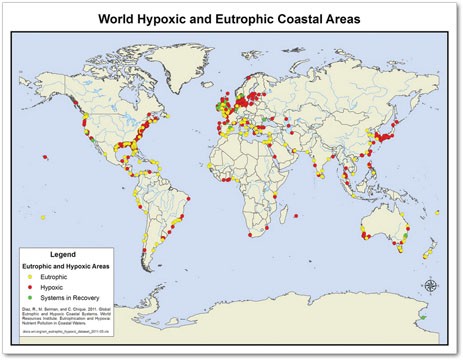Aquatic Dead Zones

By Mary Rose Thomas-Glaser
Around the world, nearly 500 coastal areas are slowly suffocating due to the lack of oxygen needed to support a diverse aquatic ecosystem. These oxygen-depleted, or hypoxic, “dead zones” result from an excess of nutrients such as nitrogen and phosphorus that causes an explosive growth of algae, phytoplankton and seaweed on the water’s surface.
These algal blooms prevent sunlight from penetrating the water surface and oxygen from being absorbed by aquatic plants and microorganisms. As the algae dies, oxygen in the water is rapidly consumed in the decomposition process. Without oxygen, shrimp, crabs, clams and other organisms that can’t quickly leave the waters are asphyxiated.
Causes of Dead Zones
Though a natural phenomenon, dead zones have been greatly exacerbated by human activities. The collective increase in farming, industrial activities and population contribute to excessive releases of nitrogen and phosphorus into the air, soil and water â a process known as eutrophication. In the U.S. and developed countries, use of fertilizers and manure in agriculture can result in contaminated runoff that enters the waterways. In third-world countries, untreated sewage and industrial wastes are often disposed of directly into waterways. Additionally, atmospheric nitrogen from burning of fossil fuels is redeposited in precipitation.
This nutrient-enriched runoff flows through creeks, streams and rivers until it reaches coastal waters where under ordinary conditions, the tides continuously mix and oxygenate the waters. However, during calm periods, when ocean currents diminish and mixing stops, colder, low-oxygen ocean waters can become trapped under lighter freshwater for extended periods. When this “stratification” occurs, a dead zone is created.
Dead zones typically occur in the spring to fall months and can last from weeks to months. The storms associated with hurricane season actually help to alleviate dead zones.
Effects of Dead Zones
One of the most acute impacts of dead zones is the immediate loss of aquatic life such as larva, shellfish and small fish at the bottom of the food chain. This loss ripples up the coastal food chain and can cause the death of marine animals and wading birds.
Some algal blooms, such as red or brown tides, contain toxic cyanobacteria that can poison fish, birds and other marine life and potentially humans. People have become seriously ill and even died from eating shellfish harvested from contaminated areas. Since shellfish are filter feeders, they absorb the microbes and toxins found in algal blooms.
Classroom Discussion
- What are the short- and long-term impacts of dead zones on aquatic biodiversity and ecosystems?
- What are sources of nitrogen pollution and how can they be reduced?
